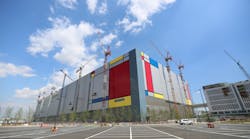Many of the largest chip companies in the world, including Nvidia and Qualcomm, outsource production of their designs. They go to contractors like TSMC and Globalfoundries that compete for orders by building more advanced factories than each other and installing the latest tools. Samsung, trying to gain ground in the $57 billion foundry market, is springing for the newest of the new.
The company announced that it would be the first to enter production using extreme ultraviolet lithography tools—more commonly known as EUV. The South Korean conglomerate has improved the output of these stepper machines so that can support volume production of chips based on Samsung’s 7-nanometer node next year. TSMC is trying to integrate EUV into its existing manufacturing lines.
The semiconductor industry has been trying to perfect these kinds of tools for the last decade. The steppers shoot high-intensity light on silicon wafers, creating circuit patterns where the light touches down with a resolution that approaches the width of individual atoms. Using EUV technology could lower the cost of manufacturing chips with smaller and smaller feature sizes, Samsung said.
EUV technology could give Samsung some slight 7-nanometer advantages over TSMC, which started production without it. Samsung said that its new 7-nanometer technology (7LPP) results in around 40 percent better area efficiency over its 10-nanometer node. It can also boost performance by 20 percent at the same power. Power consumption can be lowered 50 percent at the same frequency.
“This fundamental shift in how wafers are manufactured gives our customers the opportunity to significantly improve their products’ time to market with superior throughput, reduced layers, and better yields,” said Charlie Bae, executive vice president of sales and marketing for Samsung’s foundry unit, which holds eight percent market share. Only TSMC, Globalfoundries and UMC have bigger businesses.
Samsung is managing to produce 1,500 wafers every day using EUV tools after boosting the intensity of the light source to 280 watts. Generally, the intensity of the light determines how many wafers can be fed through the equipment per hour. Samsung, in an effort to spread out in a market expected to reach $85 billion by 2022, spun its foundry business unit into a separate organization last year.
Chips are produced by shining infinitesimally small light waves through photomasks that act like stencils, transferring patterns onto wafers coated with photosensitive chemicals. The masks expose some areas of the chip and shield others. Each chip layer is manufactured by positioning a mask with a particular pattern over the wafer and shining light through it. After all the exposed areas are etched away, individual chips are cut out and packaged.
But chips currently in development have circuitry smaller than the 193-nanometer wavelength of light used in traditional deep ultraviolet lithography (DUV). Chip manufacturers are increasingly using multi-patterning to build more intricate integrate circuits. That means splitting circuit patterns into several masks. One after another is exposed to the light until the complete circuit is burned into the silicon.
Using shorter light waves could simplify the process. EUV technology—which uses light measuring 13.5 nanometers—requires only one mask and exposure for each layer. That reduces the number of manufacturing steps and could lower the probability of defects, which affects the number of chips that can be sliced out of a wafer. Samsung says that its EUV technology uses 20-percent fewer masks.
Samsung has invested $1 billion over the years in Eindhoven, Netherlands-based ASML, the main supplier of EUV equipment. That includes almost $650 million for three-percent ownership to support EUV development. ASML’s tools cost more than $100 million each. That will increase the upfront cost of next generation factories like Samsung’s $6 billion fab targeting additional EUV production by 2020.
Samsung has also had to build custom mask-making tools and photosensitive resist materials. The company has designed unique mask inspection tool can detect defects early in the manufacturing process. Samsung has not said where it is in the development of pellicles to protect its masks from contamination. That could limit how many layers can be fabricated with EUV technology.
No early customers have been announced for the new process. Samsung's semiconductor business unit usually jumps to the front of the line for every new manufacturing process. Their chips are integrated into Samsung’s flagship smartphones. In February, Qualcomm said that it would base its new generation of 5G modems on Samsung’s 7-nanometer low power plus (7LPP) node.
The South Korean giant is trying to get the jump on TSMC, which holds more than 50 percent market share and around 400 customers including Apple and Nvidia. TSMC plans to produce 7-nanometer chips using EUV technology in the first half next year. TSMC said that the EUV-enhanced node will offer another 10 percent of power savings while occupying around 15 percent less space.
But Samsung is playing catchup with TSMC in terms of shipments. Chips based on the 7-nanometer node—including Apple’s A12 and Huawei’s Kirin—accounted for around 11 percent of TSMC’s total wafer revenue in the third quarter. Chips based on 28-nanometer and more advanced nodes represented 61 percent. TSMC reported third-quarter revenue of $8.49 billion, up two percent annually.
The competition has thinned out at the 7-nanometer node. In August, Globalfoundries ended its development of the technology—even after installing its first pair of EUV tools. The company acknowledged that it would not have had enough customers to pay off billions of investment in 7-nanometers. Its new focus is on 12-nanometers and other existing nodes targeting Internet of Things applications.
Intel is also grappling with a manufacturing crisis. The company has delayed its 10-nanometer process, which is projected to offer the same performance as rival 7-nanometer node, for the last three years. The Santa Clara, California-based company has warned that chips based on the new node will not be available until the second half of next year, long after competing products from Advanced Micro Devices.
The company will also reportedly break its manufacturing unit into three parts after the head of the division, Sohail Ahmed, steps down next month. The delays result from the company’s inability to limit defects in the chips. Bernstein researcher Mark Li estimates that Intel will not introduce EUV technology before chips based on the 7-nanometer node. These products will probably be manufactured at Intel’s Fab 42 in 2021.
Intel responded on Monday to speculation that it had resolved to end 10-nanometer development. “Media reports published today that Intel is ending work on the 10nm process are untrue,” according to a statement from Intel’s official Twitter account. “We are making good progress on 10nm. Yields are improving consistent with the timeline we shared during our last earnings report.”








